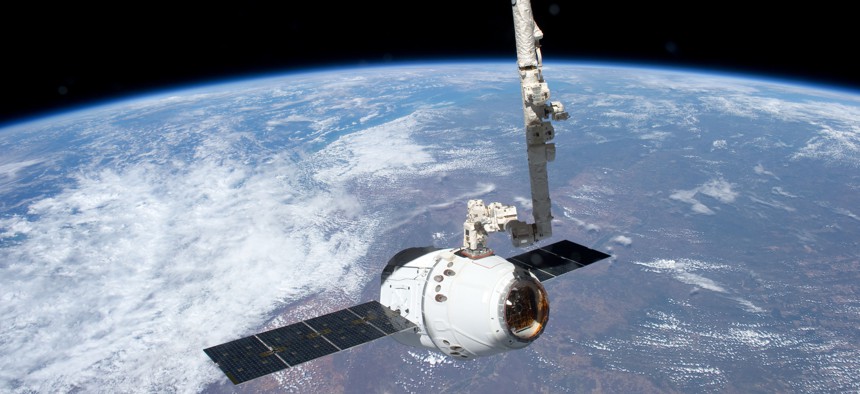
In this 2015 file photo, the Canadarm 2 reaches out to capture the SpaceX Dragon cargo spacecraft for docking to the International Space Station. NASA
Cargo Bases in Space: Air Force General Wants Them Within a Decade
The service’s mobility chief is already talking with SpaceX and other companies about the possibilities of orbiting supply dumps.
Within a decade, U.S. troops may get some supplies from prepositioned stocks in space — if the Air Force’s mobility commander can make his vision come true.
Gen. Carlton D. Everhart II is already talking with SpaceX and other space-services companies about that and other space-related initiatives, the leader of Air Force Mobility Command told reporters at a Defense Writers Group breakfast Thursday.
“What happens if we preposition cargo in space? I don’t have to use terrestrial means, I don’t have to use water means. I can just position in space and have a re-supplying vehicle come up and come back down. I don’t have to have people there, I just have to have the cargo there. Automated loading systems, those types of things,” Everhart said.
Where, exactly, would these orbiting supply dumps be?
“This is me thinking out loud,” he said.“Low earth orbit? Fine. But I’m telling you if the commercial industry is going to launch 5,000 satellites, I don’t know if it’s going to work...It’s cluttered up there. So, is it...the halfway point between the Earth and the moon? ...Maybe we can put it in GEO...I don’t know, I’m going to ask the industry…If you’ve got ideas, I’ll take them."
Everhart said the Air Force’s space-cargo missions could be modeled on SpaceX’s deliveries to the International Space Station.
The cargo Cargo] “can be anything. Obviously, if it’s food supplies, they go up there, doesn’t stay fresh. Water, that’s got to be worked through. But if you’re looking at materials, I don’t want to say dunnage, but things like that can survive in space,” he said. “Could be hardware, could be a Humvee…I’m willing to stick anything up there.”
Everhart said he believed developing space technology was pivotal for the future of the Air Mobility Command.
“It’s in the infancy stages. I’ve already written white papers, I’ve talked to Gen. Jay Raymond [the commander] at Air Force Space Command, saying ‘I want to partner,’” he said. “We’re starting to spin this up pretty good. Because what happens is, if we don’t do this, and we stay within the air domain, Air Mobility Command will become irrelevant.”
The general said the Air Force must move swiftly.
“I think in the next five years we can be right in on that concept stage,” he said. “Actual routine, probably within the next 10.”
Everhart said the Air Force would likely propose major investments in space cargo in the next Program Objective Memorandum.
“I would like to introduce that, or at least start getting the initial resources done in the next POM cycle. You know me, I’d like to get it in 2020. Honestly 2022 is too late,” he said. “I want it now. I’ve got to get these concepts now … This is the avenue for the future. If I can get it introduced and start the concepts right now, I’ll do it with my own money, I’m going to do it.”
“The bottom line is it’s not soon enough,” he added.
Everhart stressed that a partnership with industry and the initiative of younger members of the Air Force would be the key to pioneering in space, and expressed an openness to exploring different technology and concepts.
“The reason why I do this is because the young kids glom onto it,” he said. “The young airmen, they’ll glom onto it and all the sudden it starts building a fever, and the next thing you know there’s a concept, the next thing you know they say, ‘we can do this, we can build it and they will come,’ and that’s what happens. It’s pretty exciting. If you look at the things we’re doing in innovation right now, I let, and this is my term, I released the kraken. What I mean by that is I released young airmen to go to the laboratories and tell us what you want, and if it’s a viable concept then we’ll put money to it and we’ll go get it made.”






